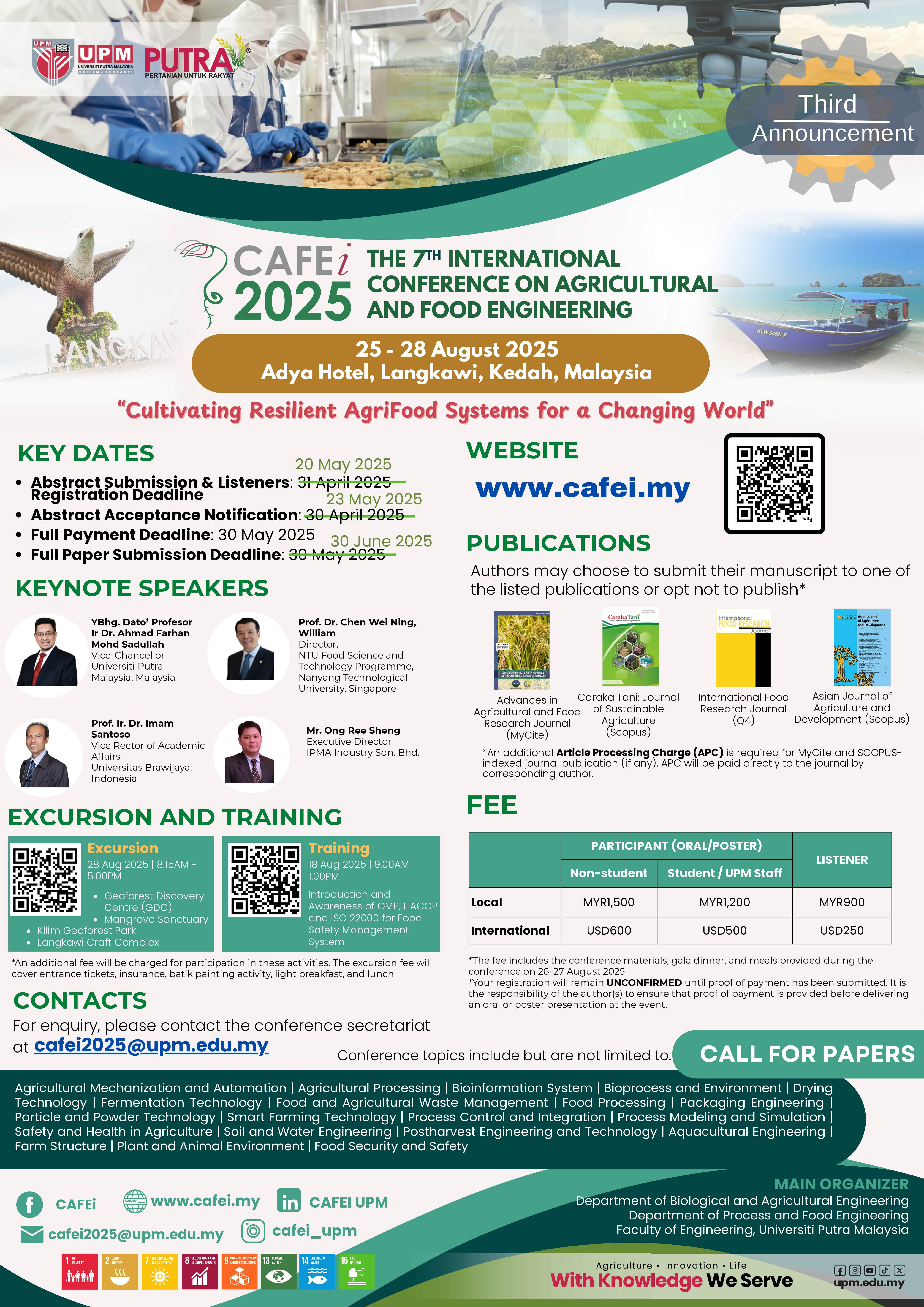Physicochemical and Functional Properties of Chicken By-Products As A Source of Animal Feed
DOI:
https://doi.org/10.36877/aafrj.a0000176Abstract
The purpose of this study was to determine the physicochemical and functional properties of chicken by-products, including head, feet, intestines and feathers that may be potential sources of animal feed. The chicken wastes are usually not converted into other useful products. Some issues present such as a bad smell, flies and dirt areas that can disrupt the impacts of the community and residents living nearby. The sample preparation was started by collecting samples from the slaughterhouse and stored under a temperature of 3-4 ⁰C before performing the analysis. The findings revealed which the chicken head and feet were higher in the percentage of protein (87.36%) and ash (4.46%) content. The intestines have higher moisture content (83.69%), fat (1.45%) and crude fiber (0.2%). The higher water absorption capacity was intestines (6.03 ml/ g) meanwhile, the feathers have a higher oil absorption capacity (8.36 ml / g) when compared to others. They had been determined the physicochemical and functional properties of chicken by-products and they have potential as a source of animal feed production.References
Berhad, L. (2014). Lay Hong Berhad. Retrieved from http://layhong.com.my/website/air-chicken-parts.html
Blok, C., De Kreij, C., Baas, R., & Wever, G. (2008). Analytical Methods Used In Soilless Cultivation. Soilless Culture, 245-289. doi:10.1016/b978-044452975-6.50009-5
Chemical Learning. (2009). Functions of Carbohydrates. Chemistry Learning. Retrieved from http://www.chemistrylearning.com/carbohydrates-functions/
Çetingül, İ. S., & Yardimci, M. (2008). The importance of fats in farm animal nutrition. Retrieved from http://dergipark.gov.tr/download/article-file/108766
Department of Food Science. (2015). Introduction to Food Chemistry (Laboratory Manual).
Helrich, K. E., & Association of Official Analytical Chemists. (1990). Official Methods of Analysis of the Association of Official Analytical Chemists (AOAC); Volume 1 (Agricultural Chemicals; Contaminants; Drugs). Retrieved from https://archive.org/details/gov.law.aoac.methods.1.1990
Horwitz, W. & Association of Official Analytical Chemists. (2000). Official methods of analysis of the Association of Official Analytical Chemists (AOAC); 17th ed. Retrieved from https://books.google.com.my/books/about/Official_methods_of_analysis_of_the_AOAC.html?id=YMRqAAAAMAAJ&redir_esc=y
Jayathilakan, K., Sultana, K., Radhakrishna, K., & Bawa, A. S. (2011). Utilization of byproducts and waste materials from meat, poultry and fish processing industries: a review. Journal of Food Science and Technology, 49(3), 278-293. doi: 10.1007/s13197-011-0290-7
Kanu, P. J., Kanu, J. B., H. Sandy, E., B.A. Kande, J., Mornya, P. M., & Huiming, Z. (2009). Optimization of Enzymatic Hydrolysis of Defatted Sesame Flour by Different Proteases and their Effect on the Functional Properties of the Resulting Protein Hydrolysate. American Journal of Food Technology, 4(6), 226-240. doi:10.3923/ajft.2009.226.240
Kazemi-Bonchenari, M., Alizadeh, A. R., Javadi, L., Zohrevand, M., Odongo, N. E., & Salem, A. Z. M. (2017). Use of poultry pre-cooked slaughterhouse waste as ruminant feed to prevent environmental pollution. Journal of Cleaner Production, 145, 151–156. https://doi.org/10.1016/j.jclepro.2017.01.066
Lin, C. S., & Zayas, J. F. (1987). Functionality of Defatted Corn Germ Proteins in a Model System: Fat Binding Capacity and Water Retention. Journal of Food Science, 52(5), 1308-1311. doi:10.1111/j.1365-2621.1987.tb14070.x
Malmali, M., Askegaard, J., Sardari, K., Eswaranandam, S., Sengupta, A., & Wickramasinghe, S. R. (2018). Evaluation of ultrafiltration membranes for treating poultry processing wastewater. Journal of Water Process Engineering, 22(March), 218–226. https://doi.org/10.1016/j.jwpe.2018.02.010
Organic Chicken Feed. (2011). Chickens Digestive System. Retrieved from https://organicchickenfeed.com/chickens-digestive-system
Puteri Nurain, M. A. A. (2018). Potential of Chicken By-Products As Animal Feed (Bachelor's Thesis). Universiti Putra Malaysia.
Quarters, C. (2013, June 21). Purpose of Ash in Animal Feed. Retrieved from https://animals.mom.me/purpose-ash-animal-feed-5742.html
Rodríguez-Ambriz, S. L., Martínez-Ayala, A. L., Millán, F., & Dávila-Ortíz, G. (2005). Composition and Functional Properties of Lupinus campestris Protein Isolates. Plant Foods for Human Nutrition, 60(3), 99-107. doi:10.1007/s11130-005-6835-z
Seong, P. N., Cho, S. H., Park, K. M., Kang, G. H., Park, B. Y., Moon, S. S., & Ba, H. Van. (2015). Characterization of chicken by-products by mean of proximate and nutritional compositions. Korean Journal for Food Science of Animal Resources, 35(2), 179–188. https://doi.org/10.5851/kosfa.2015.35.2.179
Taheri, A., Anvar, S., Ahari, H., & Fogliano, V. (2013). Comparison the functional properties of protein Hydrolysates from poultry byproducts and rainbow trout.
Tesfaye, T., Sithole, B., Ramjugernath, D., & Chunilall, V. (2017). Valorisation of chicken feathers: Characterisation of physical properties and morphological structure. Journal of Cleaner Production, 149, 349-365. doi:10.1016/j.jclepro.2017.02.112
Van Saun, R. J., & Herdt, T. (2014). Nutritional Assessment. Llama and Alpaca Care, 100-123. doi:10.1016/b978-1-4377-2352-6.000
Downloads
Published
How to Cite
Issue
Section
License
Copyright (c) 2021 Puteri Nurain Megat Ahmad Azman, Rosnah Shamsudin, Hasfalina Che Man, Mohammad Effendy Ya'acob

This work is licensed under a Creative Commons Attribution-NonCommercial 4.0 International License.
Author(s) shall retain the copyright of their work and grant the Journal/Publisher right for the first publication with the work simultaneously licensed under:
Creative Commons Attribution-NonCommercial 4.0 International (CC BY-NC 4.0). This license allows for the copying, distribution and transmission of the work, provided the correct attribution of the original creator is stated. Adaptation and remixing are also permitted.

This broad license intends to facilitate free access to, as well as the unrestricted reuse of, original works of all types for non-commercial purposes.
The author(s) permits HH Publisher to publish this article that has not been submitted elsewhere.

.png)

.jpg)



